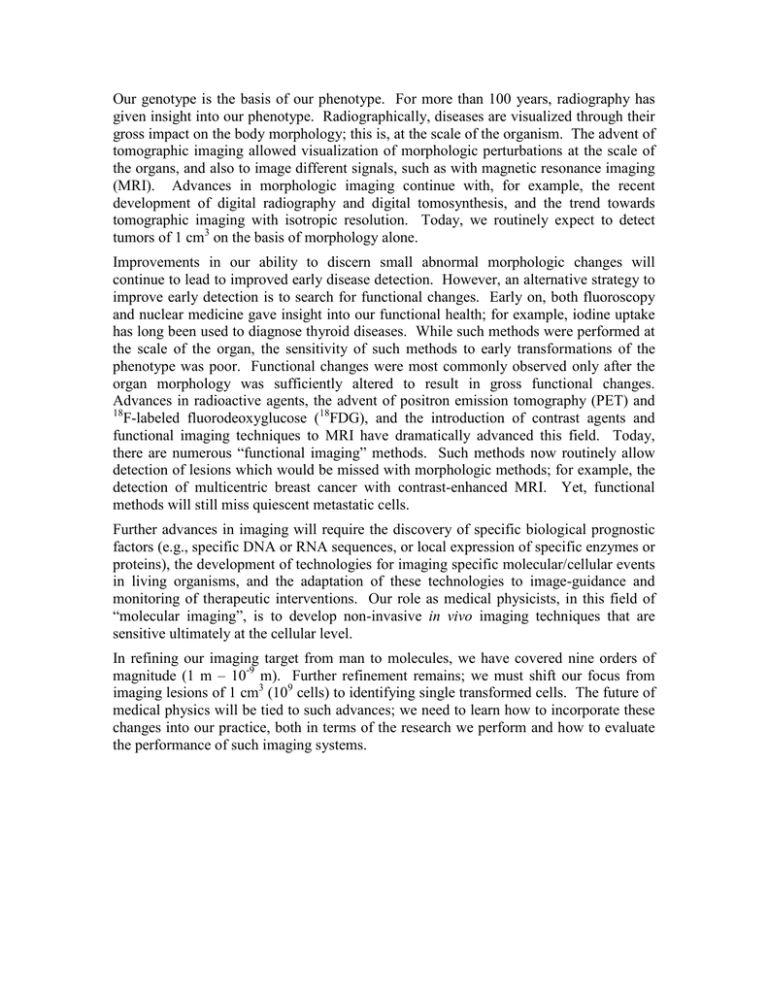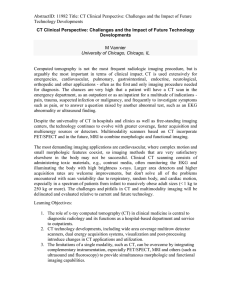Our genotype is the basis of our phenotype. For... given insight into our phenotype. Radiographically, diseases are visualized...
advertisement

Our genotype is the basis of our phenotype. For more than 100 years, radiography has given insight into our phenotype. Radiographically, diseases are visualized through their gross impact on the body morphology; this is, at the scale of the organism. The advent of tomographic imaging allowed visualization of morphologic perturbations at the scale of the organs, and also to image different signals, such as with magnetic resonance imaging (MRI). Advances in morphologic imaging continue with, for example, the recent development of digital radiography and digital tomosynthesis, and the trend towards tomographic imaging with isotropic resolution. Today, we routinely expect to detect tumors of 1 cm3 on the basis of morphology alone. Improvements in our ability to discern small abnormal morphologic changes will continue to lead to improved early disease detection. However, an alternative strategy to improve early detection is to search for functional changes. Early on, both fluoroscopy and nuclear medicine gave insight into our functional health; for example, iodine uptake has long been used to diagnose thyroid diseases. While such methods were performed at the scale of the organ, the sensitivity of such methods to early transformations of the phenotype was poor. Functional changes were most commonly observed only after the organ morphology was sufficiently altered to result in gross functional changes. Advances in radioactive agents, the advent of positron emission tomography (PET) and 18 F-labeled fluorodeoxyglucose (18FDG), and the introduction of contrast agents and functional imaging techniques to MRI have dramatically advanced this field. Today, there are numerous “functional imaging” methods. Such methods now routinely allow detection of lesions which would be missed with morphologic methods; for example, the detection of multicentric breast cancer with contrast-enhanced MRI. Yet, functional methods will still miss quiescent metastatic cells. Further advances in imaging will require the discovery of specific biological prognostic factors (e.g., specific DNA or RNA sequences, or local expression of specific enzymes or proteins), the development of technologies for imaging specific molecular/cellular events in living organisms, and the adaptation of these technologies to image-guidance and monitoring of therapeutic interventions. Our role as medical physicists, in this field of “molecular imaging”, is to develop non-invasive in vivo imaging techniques that are sensitive ultimately at the cellular level. In refining our imaging target from man to molecules, we have covered nine orders of magnitude (1 m – 10-9 m). Further refinement remains; we must shift our focus from imaging lesions of 1 cm3 (109 cells) to identifying single transformed cells. The future of medical physics will be tied to such advances; we need to learn how to incorporate these changes into our practice, both in terms of the research we perform and how to evaluate the performance of such imaging systems.





